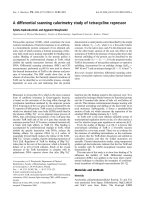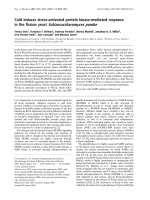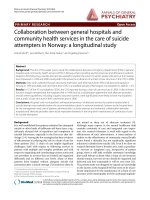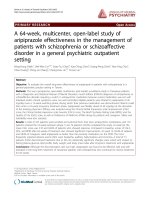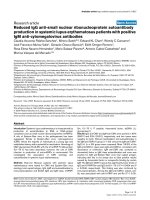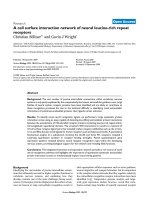Báo cáo y học: "A 64-week, multicenter, open-label study of aripiprazole effectiveness in the management of patients with schizophrenia or schizoaffective disorder in a general psychiatric outpatient setting" pptx
Bạn đang xem bản rút gọn của tài liệu. Xem và tải ngay bản đầy đủ của tài liệu tại đây (679.33 KB, 9 trang )
PRIMARY RESEARCH Open Access
A 64-week, multicenter, open-label study of
aripiprazole effectiveness in the management of
patients with schizophrenia or schizoaffective
disorder in a general psychiatric outpatient
setting
Ming-Hong Hsieh
1
, Wei-Wen Lin
2,3*
, Shao-Tsu Chen
4
, Kao-Ching Chen
5
, Kuang-Peng Chen
6
, Nan-Ying Chiu
7
,
Chao Huang
8
, Ching-Jui Chang
9
, Cheng-Hsiu Lin
10
, Te-Jen Lai
1
Abstract
Objective: To evaluate the overall long-term effectiveness of aripiprazole in patients with schizophrenia in a
general psychiatric practice setting in Taiwan.
Methods: This was a prospective, open-label, multicenter, post-market surveillance study in Taiwanese patients
with a Diagnostic and Statistical Manual of Mental Disorders, Fourth Edition (DSM-IV) diagnosis of schizophrenia or
schizoaffective disorder requiring a switch in antipsychotic medication because current medication was not well
tolerated and/or clinical symptoms were not well controlled. Eligible patients were titrated to aripiprazole (5-30
mg/day) over a 12-week switching phase, during which their previous medication was discontinued. Patients could
then enter a 52-week, long-term treatment phase. Aripiprazole was flexibly dosed (5-30 mg/day) at the discretion
of the treating physicians. Efficacy was assessed using the Clinical Global Impression scale Improvement (CGI-I)
score, the Clinical Global Impression scale Severity (CGI-S) score, The Brief Psychiatry Rating Scale (BPRS), and the
Quality of Life (QOL) scale, as well as Preference of Medicine (POM) ratings by patients and caregivers. Safety and
tolerability were also assessed.
Results: A total of 245 patients were enrolled and switched from their prior antipsychotic medications, and 153
patients entered the 52-week exten sion phase. In all, 79 patients (32.2%) completed the study. At week 64, the
mean CGI-I score was 3.10 and 64.6% of patients who showed response. Compared to baseline, scores of CGI-S,
QOL, and BPRS after 64 weeks of treatment also showed significant improvements. At week 12, 65.4% of sub jects
and 58.9% of caregivers rated aripiprazole as better than the prestudy medication on the POM. The most
frequently reported adverse events (AEs) were headache, auditory hallucinations and insomnia. A total of 13
patients (5.3%) discontinued treatment due to AEs. No statistically significant changes were noted with respect to
fasting plasma glucose, lipid profile, body weight, and body mass index after long-term treatment with aripiprazole.
Conclusions: Although the discontinuation rate was high, aripiprazole was found to be effective, safe and well
tolerated in the long-term treatment of Taiwanese patients with schizophrenia who continued to receive treatment
for 64 weeks.
* Correspondence:
2
Department of Psychiatry, Tri-Service General Hospital, National Defense
Medical Center, Taipei, Taiwan
Full list of author information is available at the end of the article
Hsieh et al. Annals of General Psychiatry 2010, 9:35
/>© 2010 Hsieh et al; licensee BioMed Central Ltd. This is an Open Access article distributed under the terms of the Creative Commons
Attribution License (http://creativecom mons.org/licenses/by/2.0), which permits unrestricted use, distribution, and reproduction in
any medium, provided the original work is properly cited.
Background
Randomized, placebo-controlled studies using strict
inclusion and exclusion criteria are essent ial when eval-
uating the efficacy and safety of a new treatment; how-
ever, they do not provide a measure of overall
effectiveness (that is, whether or not the treatment
works in real-world clinical practice) [1,2]. Effectiveness
is a more global measure that considers not only efficacy
and tolerability but also broader issues related to every-
day clinical care such as patient preference [2]. Effective-
ness studies are especially relevantwheretheremaybe
differences in the standard of care or treatment prac-
tices, such as in countries where differences in health-
care systems and cultural preferences may further
impact on treatment effectiveness.
Antipsychoticdrugsaretheprimarytreatment
option for schizophrenia [3] and are increasingly stu-
died in real-world settings. Although typical antipsy-
chotic agents have a long history of use and are still
used extensively in some parts of the world, atypical
antipsychotics provide some advantages [3]. Atypical
agents are effective in reducing both the positive and
negative symptoms of schizophrenia and are also asso-
ciated with a lower incidence of extrapyramidal symp-
toms and hyperprolactinaemia, both side effects that
are commonly associated w ith typical antipsychotic
agents [3].
Aripiprazole is a novel atypical antipsychotic with
potent partial dopamine receptor D
2
and D
3
agonist
activity [4,5], serotonergic 5-hydroxytryptamine (5-HT)
2A
antagonist activity [6] and 5-HT
1A
partial agonist
activity [7,8]. In addition, aripiprazole has minimal affi-
nity for a2 adrenergic receptors, H
1
histamine receptors
and muscarinic cholinergic receptors [9,10], possibly
underlying the diminished liability of aripiprazole to
produce orthostatic hypotension, sedation and weight
gain, and cognitive impairment, respectively.
Aripiprazole has been shown to be efficacious and well
tolerated for the treatment of schizophrenia in short-
term (4-6 weeks) [11-15] and longer-term (26 and 52
weeks) clinical trials [9,12,16,17]. However, whether
these findings will translate into long-term improve-
men ts in real-life clinical practice in a Taiwanese popu-
lation warrants further study. Here, we report the
results of a multicent er, open-label, post-mar ket surveil-
lance study to evaluate the overall long-term effective-
ness of aripiprazole in Taiwanese patients with
schizophrenia or schizoaffective disorder in a general
psychiatric practice setting. The effectiveness of aripipra-
zole was evaluated in patients switching from other anti-
psychotic agents and the study was designed to reflect
general psychiatric treatment practice.
Methods
Study design
This was a prospective, open-label, multicenter, post-
market surveillance study to evalua te the long-term
efficacy and safety of aripiprazole for the treatment of
schizophrenia. The study took place between August
2006 and December 2008 at nine centers under the
latest applicable International Conference on Harmoni-
sation of Technical Requirements for Registration of
Pharmaceuticals for Human Use (ICH) Good Clinical
Practice (GCP), Gu idelines of Taiwan and in accordance
with the Declaration of Helsinki. The study protocol
was approved by an Institutional Review Board commit-
tee from the nine medical centers, and all patients were
required to provide written inform ed consent to partici-
pate. The study consisted of two phases: a 12-week
switching phase during which time eligible subjects were
switched from their current treatment to aripiprazole,
followed by a 52-week long-term treatment phase
during which subjects continued aripiprazole treatment
for an additional 52 weeks.
Subjects
This study enrolled male and female subjects, aged
18-65 years, with a Diagnostic and Statistic al Manual of
Mental Disorders, Fourth Edition (DSM-IV) diagnosis of
schizophrenia or s chizoaffective disorder. Patients were
required to be currently taking antipsychotic drugs but
warranting a change of antipsychotic medication
because medication was not well tolerated and/or clini-
cal symptoms were not well controlled, based on the
clinical judgment of the investigator.
Patients were excluded from the study if they had
acute psychosis, acute suicidal ideation, any acute psy-
chiatric condition that might require emergent interven-
tion, organic, neurological, cardiovascular diseases, or if
they had a history of drug or a lcohol abuse within the
last 12 weeks. Other exclusion criteria were pregnant or
breastfeeding women, or those planning a pregnancy
during the study period; those receiving electroconvul-
sive therapy within 4 weeks prior to the screening visit;
and those with a known allergic reaction to any antipsy-
chotic medication (including but not limited to haloperi-
dol, chlorpromazine, thioridazine, pimozide, risperidone,
quetiapine and ziprasidone) . Subjects with any clinical
condition or significant concurrent disease judged by
the investigator to complicate the evaluation of the
study treatment were also excluded, as were those hav-
ing participated in another study or taken the investiga-
tion drug within 1 month prior to study entry. Depot
neuroleptics were discontinued at least 2 months prior
to enrollment.
Hsieh et al. Annals of General Psychiatry 2010, 9:35
/>Page 2 of 9
Study treatments
Eligible subjects received their f irst dose of aripiprazole
at the start of the switching treatment period, the start-
ing dose of which was determined by the investigator.
After 2 weeks of adverse event (AE)-free aripiprazole
dosing, the treating physicians could increase the dose
of aripiprazole to a maximum of 30 mg/day. Dosing
could be reduced at any time due to tolerability. During
the switching period (weeks 8-12), all prior antipsychotic
medications were gradually discontinued; treatment with
antipsychotics other than aripiprazole was not permitted
during the 52-week long-term treatment phase. Treat-
ment compliance was measured as the percentage of the
actual days of drug dispensed divided by the expected
days of drug dispensed based on the assessment sche-
dule. Patients with values between 80% and 100% were
considered to be treatment compliant . Of the 153
patients enrolled in the study, 106 patients (69.2%) were
compliant with treatment.
Concomitant treatment with lorazepam and/or
diphenhydramine was permitted during switching for
the treatment of AEs but was not permitted during
long-term treatment. Additionally, psychotrophic drugs
other than antipsychotics were permitted throughout
the study based on clinical judgment.
Study assessments
Subjects were evaluated at baseline (week 0), weeks 2, 8
and 12 of the sc re ening phase and 24, 38, 51 and 64 of
the long-term treatment phase. During screening, addi-
tional visits could also be conducted at weeks 4 and 6
based on the chosen titration schedule of the
investigator.
Effectiveness was evalua ted using the Clinical Global
Impression scale Improvement (CGI-I) score [18], the
mean change from baseline in Clinical Global Impres-
sion scale Severity of Illness (CGI-S) score, the total
score on the Brief Psychiatric Rating Scale (BPRS) [19],
and the total score on the World Health Organization
Quality of Life instrument, short version (WHOQOL-
BREF) [20] questionn aire. Additional effectiveness mea-
sures included the CGI response rate (defined as a CGI-
I score of 1 (very much improved), 2 (much improved)
or 3 (minimally improved)) and the Preference of Medi-
cine (POM) questionnaire completed during the 12-
week switching phase by patients and caregivers [21].
All rating scales were completed by the treating
physicians.
Safety measures included frequency and severity of
AEs, serious AEs (SAEs); discontinuation due to AEs,
abnormal laboratory results, physical examination, vital
signs, body mass index (BMI), waist/hip measurement
and metabolic syndrome parameters.
Statistical procedures
The safety population was defined as all patients who
received at least one dose of study medication, whereas
the effectiveness population included all subjects who
took at least one dose of study medication and had at
least one post-baseli ne effectiveness measure. Continu-
ous variables are presented as mean, standard deviation,
median, range, and 95% confidence intervals (CIs).
Paired t-tests were performed to compare baseline
versus post-treatment. Categorical variables are pre-
sented in frequency tables. All analys es were performed
on the observed case data set for each study week using
the last observation carried forward (LOCF) method to
handle missing data at study endpoint.
Clinical trials registry
This study is registered with clinicaltrials.gov under the
accession number NCT00520650.
Results
Subject demographics
A total of 24 5 subjects were enrolled in this study, of
whom 153 completed the 12-week switching phase and
entered long-term treatment.Overall,79subjects
(32.2%) completed the study. Subject disposition is
shown in Figure 1. Subject baseline demographic char-
acteristics are shown in Table 1.
Study treatments
Antipsychotics received during switching included chlor-
promazine (n = 2), clothiapine (n = 2), flupenthixol
(n = 2), loxapine succinate (n = 1), sulpiride (n = 13),
trifluoperazine (n = 1), haloperidol (n = 27), amisulpride
(n = 14), risperidone (n = 89), ziprasidone (n = 13),
zotepine (n = 14), clozapine (n = 5), olanzapine (n = 40)
and quetiapine (n = 15). The mean ± SD aripiprazole
daily dosage at the start of treatment was 8.93 ± 3.60
mg/day and 13.86 ± 6.46 mg/day at the f inal treatment
(week 51).
During the first week of treatment, 29.0% of subjects
were receiving aripiprazole at doses of ≤5 mg/day; 67.4%
were receiving > 5 mg/day and ≤15 mg/day, 3.3% were
receiving >15 mg/day and ≤20 mg/day, and 0.4% were
receiving >20 mg/day. At week 51 (n = 81), 9.9% of sub-
jects were receiving aripiprazole at doses of ≤ 5 mg/day;
61.7% were re ceiving >5 mg/day and ≤15 mg/day, 19.8%
were receiving >15 mg/day and ≤20 mg/day, and 8.6%
were receiving >20 mg/day. Of the 153 patients enrolled
in the study, 106 patients (69.2%) were compliant with
treatment.
During the 12-week switching period, no patients
received diphenhydramine and five patients received
lorazepam for the treatment of restlessness.
Hsieh et al. Annals of General Psychiatry 2010, 9:35
/>Page 3 of 9
Efficacy
Mean CGI-I scores over the course of the study are
shown in Figure 2. Mea n CGI-I scores showed improve-
ment during the co urse of the study; at week 64, the
mean CGI-I score was 3.10 (95% CI 2.9 to 3.3). At end-
point (LOCF), the mean CGI-I score was 3.69 (95% CI
3.5 to 3.9). Figure 3 shows the percentage of subjects
with a response (CGI-I score of very much or much
improved or minimally improved) to treatment by study
week. Response rates with aripiprazole were 64.6% and
47.8%atweek64andstudyendpoint(LOCF),
respectively.
Mean changes from baseline in QOL, CGI-S and
BPRS ratings are shown in Table 2. Significant improve-
ments were observed in scores of QOL, CGI-S and
BPRS over the course of treatment compared to baseline
(3.6 ± 12.0, P < 0.05; -0.7 ± 1.1, P < 0.001; -9.3 ± 11.6,
P < 0.001, respectively).
Preference of medicine ratings
The percentage of patients and their caregivers rating
study medication as ‘much better’ or ‘ slightly better’
than their previous antipsy chotic medication during the
12-week switching period is shown in Figure 4. Both
patient and caregiver POM ratings for aripiprazole
increased during the 12-week switching phase. At the
end of the switching phase (LOCF), 54.7% of 123 sub-
jects and 48.0% of 108 caregivers rated aripiprazole as
‘slightly better’ or ‘much better’ than the prestudy medi-
cation. For patients completing 12 weeks of treatment,
65.4% of subjects and 58.9% of caregivers rated aripipra-
zole as ‘ slightly better’ or ‘much better’ than the
prestudy medication.
Safety and tolerability
Of the 245 subjects who were included in the safety
sample, 163 (66.5%) experienced an AE during the
switching treatment phase and, of the 153 subjects who
entered long-term treatment, 110 (71.9%) of subjects
Figure 1 Patient disposition.
Table 1 Baseline demographics characteristics (safety
sample)
N Aripiprazole (n =
245)
Gender, n (% male) 100 (40.8)
Mean ± SD age, years 37.0 ± 10.9
Schizophrenia, n (%) 244 (99.6)
Social history:
Positive smoking history, n (%) 232 (94.7)
Alcohol or drug abuse within last 12 weeks, n
(%)
0
CGI-S 3.84 ± 1.07
CGI-S = Clinical Global Impression scale Severity of Illness score.
Hsieh et al. Annals of General Psychiatry 2010, 9:35
/>Page 4 of 9
experienced an AE. AEs that occurred in ≥5% of sub-
jectsareshowninTable3.Themostfrequently
report ed AEs (occurring in ≥10% of subjects) during the
ent ire study were headache, auditory hallucinations and
insomnia. Most AEs were mild to moderate in severity.
Discontinuations due to AEs occurred in 13 (5.3%)
subjects. Adverse ev ents leading to discontinua tion
included vision blurred, abdominal distension, dry
mouth, nausea, irritability, dizziness, headache, syncope,
aggression, agitation, disorientation, impulse control dis-
order, insomnia, persecutory delusion, psychotic disor-
der, restlessness, suspiciousness and thinking abnormal
(all n = 1) and auditory hallucinations ( n = 2); subjects
may have discontinued treatment due to more than one
AE. In addition, two subjects committed suicide during
the study (one during switching and one during long-
term treatment); both events were judged as being
possibly related to study medication.
Serious AEs (SAEs) were reported in 43 (17.6%) subjects;
of these, 9 were judged as being unlikely to be related to
study drug, 14 as being unrelated to study drug, 11 a s
being possibly related to study drug, and 9 as being prob-
ably related to study medication by the investigators.
No clinically relevant changes in vital signs or other
laboratory findings were observed over the course of
treatment.
Body weight and metabolic abnormalities
The mean ± SD weight was 67.3 ± 15.7 kg at baseline.
For subjects continuing to receive treatment for
Figure 2 Mean CGI-I score by study week (eff ectiveness sample). CGI-I = Clinical Global Impression scale Improvement score; LOCF = last
observation carried forward.
Figure 3 Response rate by study week. Response = CGI-I score of 1 (very much improved), 2 (much improved) and 3 (minimally improved).
CGI-I = Clinical Global Impression scale Improvement score.
Hsieh et al. Annals of General Psychiatry 2010, 9:35
/>Page 5 of 9
64 weeks, the mean weight increased over the course of
treatment (68.9 ± 15.4 kg at week 64). The mean weight
at study endpoint (LOCF) decreased (66.8 ± 15.1 kg).
Neither of these changes from baseline were statistically
significant. Mean ± SD BMI was 25.4 ± 5.2 kg/m
2
at
baseline and was not significantly different at week 64
(25.8 ± 4.9 kg/m
2
; P = 0.719).
No statistically significant changes from baseline were
noted for waist circumference, BMI, blood pressure, or
high-density lipoprotein (HDL) levels. There was a sig-
nificant reduction in the mean ± SD total cholesterol
(baseline 185.6 ± 46.9 vs week 64 179.3 ± 38.8; P <
0.05), triglycerides (baseline 144.8 ± 150.7 vs week 64
120.0 ± 93.6; P < 0.001) and fasting plasma glucose
(baseline 101.3 ± 39.1 vs week 64 96.7 ± 33.3; P <0.05)
over the course of aripiprazole treatment. There was a
shift in glucose status over the course of treatment
towards improvement; at baseline, 89.8% of subjects had
normal blood glucose levels, whereas at week 64 and
endpoint, 97.5% and 90.4% of subjects had normal
levels, respectively.
Prolactin
Aripiprazole treatment was associated with a signifi-
cant decrease in serum prolactin levels over the course
of treatment. At baseline, the mean ± SD serum pro-
lactin level was 55.3 ± 60.9 ng/mL and at week 64 the
mean ± SD prolactin level was 6.14 ± 5.46 ng/mL (P <
0.001). Only one subject reported hyperprolactinaemia
as an AE.
Discussion
Aripiprazole has previously been shown to be efficacio us,
safe, and well tolerated in randomized, placebo-con-
trolled and active-controlled clinical trials [11,12,16,17].
This prospective, open-label, naturalistic study was
designed to specifically eval uate the effectiveness of
Table 2 Mean change from baseline in additional
effectiveness outcomes (effectiveness sample)
Outcome Mean ± SD
WHOQOL-BREF:
Baseline 71.0 ± 14.1
Change from baseline to week 12 2.2 ± 12.5*
Change from baseline to week 64 3.6 ± 12.0*
Change from baseline to endpoint (LOCF) 2.2 ± 11.3**
CGI-S:
Baseline 3.8 ± 1.1
Change from baseline to week 12 -0.6 ± 1.0***
Change from baseline to week 64 -0.7 ± 1.1***
Change from baseline to endpoint (LOCF) -0.3 ± 1.1***
BPRS:
Baseline 49.8 ± 17.5
Change from baseline to week 12 -6.5 ± 10.5***
Change from baseline to week 64 -9.3 ± 11.6***
Change from baseline to endpoint (LOCF) -5.8 ± 15.9***
*P < 0.05 vs baseline; **P < 0.01 vs baseline; ***P < 0.001 vs baseline.
BPRS = Brief Psychiatric Rating Scale; CGI-S = Clinical Global Impression scale
Severity of Illness score; LOCF = last observation carried forward; WHOQOL-
BREF = World Health Organization Quality of Life instrument, short version.
Figure 4 Percentage of patients and their caregivers rating study medication as better than the previous antipsychotic medication
during the 12-week switching period. Subjects with a preference of medication rating of ‘much better’ or ‘slightly better’ were included in
the total.
Table 3 Adverse events occurring at an incidence ≥5%
Adverse event n (%)
Headache 28 (11.4)
Hallucination, auditory 26 (10.6)
Insomnia 26 (10.6)
Constipation 23 (9.4)
Akathisia 14 (5.7)
Extrapyramidal disorder 13 (5.3)
Upper respiratory tract infection 13 (5.3)
Tremor 13 (5.3)
Hsieh et al. Annals of General Psychiatry 2010, 9:35
/>Page 6 of 9
aripiprazole in a general outpatient psychiatric practice
setting and to evaluate the effectiveness of aripiprazole in
a Taiwanese patient population. Findings reported here
demonstrate the broad effectiveness of aripiprazole in
Tai wanese patients with schizophrenia or schizoaffective
disorder and suggest that treatment is effective for up to
1 year of treatment. Mean CGI-I scores showed improve-
ment over the course of b oth short-term and long-term
treatment and the distribution of CGI-I scores at week
64 suggests that aripiprazole improved symptoms in a
large proportion of patients; 64.6% of subjects had a clini-
cally relevant improvement in symptoms at week 64, as
measured by improvement in CGI-I scores. Furthermore,
just over half of subjects who completed the switching
treatment phase went on to receive 52 weeks of long-
term treatment. Importantly, improvements in symptoms
of schizophrenia were not limited to clinician assessment
of symptoms; improvement in quality of life measured
using the WHOQOL-BREF was also seen over the both
short-term and long-term treatment period.
Results from this study suggest that patients requiring
a switch in antipsychotic medication can benef it from
switching to aripiprazole treatment in both the short
and long term. In this study, patients and their care-
givers generally preferred aripiprazole to their previous
medication(s), as assessed using the preference of medi-
cation scale scores during the switching treatment
phase. This fi nding, coupled with the improvement in
QOL ratings, is important as it provides an estimation
of the real-world impact of antipsychoti c treatment with
aripiprazole. As poor compliance is a primary reason for
relapse [22], improvements in preference of medication
(patient and caregiver) and QOL outcomes cannot be
undervalued. However, longer-term studies using func-
tional and social outcomes are needed to assess whether
POM and QOL translate into meaningful changes in the
long-term naturalistic treatment setting, such as improv-
ing the ability to return to work, reintegration with
family, friends and improved social relatedness.
Although discontinuation rates over the 64 weeks of
treatment were high, they are comparable to those
reported with aripiprazole in other studies of similar
durati on [16,23] and high attrition rates are not uncom-
mon in long-term trials [1] . It is, however, interesting to
note that withdrawal of consent was the primary reason
for study discontinuation during both the switching
and long-term treatment phases. Although the most
common reason for withdrawal of consent resulted from
changes in personal circumstances, whether this was
indirectly related to aripiprazole treatment is unknown.
The findings reported here in the Taiwanese popula-
tion here are in agreement with previous prospective
8-week effectiveness trials of aripiprazole in patients
with schizophrenia conducted in the US [21] and
Europe [24]. These studies evaluated the broad effective-
ness of aripiprazole in patients with schizophrenia and
also reported a high proportion of patients preferring
aripiprazole treatment over their previous medication
when switching medication [21,24]. The findings
reported here also agree with those of the Schizophrenia
Trial of Aripiprazole (STAR) study, which demonstrated
the longer-term effectiveness of aripiprazole for the
treatment of schizophrenia in Europe [25]. This study
demonstrated the effectiv eness of aripiprazole compared
with standard-of-care treatment in outpatient-treated
patients with schizophrenia, especially in the areas of
symptom improvement, clinical response, patient medi-
cation preference, and quality of life. The effectiveness
of aripiprazole was also supported on a number of phy-
sical health dimensions [25].
Aripiprazole was generally well tol erated as a long-
term treatment in this population, most AEs were mild
to moderate in severity and discontinuations due to AEs
were low. Furthermore, AEs reported here were consis-
tent with findings from both long-term, randomized,
placebo-controlled trials of treatment with aripiprazole
in patients with schizophrenia [17] and findings from
other long-term naturalistic studies [24]. It should be
noted that, although two subjects committed suicide
during this study, these events were only possibly related
to study medication.
The metabolic side effects of medication , such as obe-
sity, dyslipidemia, hyperglycemia and glucose intoler-
ance, are an important consideration with long-term
treatment due t o their association with cardiovascular
disease [26]. Furthermore, the atypical antipsychotics
have been shown to differ significantly with respect to
their effect on weight gain, plasma lipid levels, and insu-
lin resistance [26,27]. Long-term aripiprazole treatment
was not associated with a worsening of metabolic para-
meters in this study and, indeed, resulted in improve-
ments in cholesterol, triglyceride and fasting plasma
glucose levels at study endpoint compared to baseline. It
should also be noted that there was a shift in glucose
status over the course of tre atment, with more patients
having normal blood glucose levels at study end com-
pared to baseline. Improvements in metabolic para-
meters following switching to aripiprazole has previously
been observed [28] and suggests that patients developing
metabolic abnormalities while receiving treatment with
other antipsychotic agents may benefit from switching
to aripiprazole.
Hyperprolactinemia, which is associated with some
antipsychotic treatments, has a number of potential
adverse clinical consequences, such as galactorrhea and
gynecomastia, or endocrine-related secondary effe cts,
such as sexual and reproductive dysfunction [29]. In the
current study, long-t erm aripiprazol e treatment was not
Hsieh et al. Annals of General Psychiatry 2010, 9:35
/>Page 7 of 9
associated with hyperprolactinaemia, but conversely a
lowering of serum prolactin levels. T his phenomenon
can be explained by t he pharmacodynamic m echanism
of aripiprazole; partial agonist activity at D
2
receptors.
This does not lead to complete blockade of D
2
receptors
in the tuberoinfundibular tract, which is known to cause
hyperprolactinaemia. Risperidone has also been studied
as a long-term treatment in Taiwanese patients [30]. In
this study, both oral risperidone and risperidone long-
acting injection were shown to be effective and well
tolerated over 48 weeks of treatment. Although oral ris-
peridone increases serum prolactin levels, risperidone
long-acting injection decreased serum prolac tin levels
over the course of treatment.
This study used a naturalistic study design that
included a number of features designed to closely reflect
clinical practice, such as the use of flexible study dosing
and titration schedules based on clinical judgment and
the use of relatively lenient inclusion and exclusion cri-
teria compared to trials conducted for regulatory
approval. However, it should be noted that the study did
exclude subject s with current substance abuse or several
somatic medical condi tions. This may limit the general-
izability of the study’ s findings as the population
included in this study may not be fully representative of
all patient types encountered in real-world settings.
Furthermore, the findings reported here should also be
interpreted within the context of the open-label study
design. Additional limitations include the lack of com-
prehensive assessment on symptom improvement and
the relatively high rate of study discontinuation. Finally,
as this was not a controlled study, conclusions regarding
the relative efficacy of aripiprazole compared with other
antipsychotics in this Taiwanese population cannot be
made.
Conclusions
This is one of the longe st studies conducted in a Taiwa-
nese patient population and provides valuable informa-
tion on the use of aripiprazole for the treatment of
schizophrenia in this patient group, despite the relatively
high discontinuation rates. Aripiprazole resulted in clini-
call y meaningful improvement in the symptoms of schi-
zophrenia that were evident throughout the 64 weeks of
study treatment. Importantly, aripiprazole was well tol-
erated, supporting the broad effectiveness of aripiprazole
for the treatment of schizophrenia in this patient group.
Acknowledgements
This study was supported by Otsuka Pharmaceutical. Editorial support for the
preparation of this manuscript was provided by Ogilvy Healthworld Medical
Education; funding was provided by Otsuka Pharmaceutical. The authors
would like to thank the following co-investigators: Nian-Sheng Tzeng, San-
Yuan Huang and Yi-Chyan Chen (Tri-Service General Hospital); Chun-Te Lee
(Chung Shan Medical University Hospital); Chaucer CH Lin, Hsiang-Chang
Wang, Hsin-Chi Tsai, Yu-Chih Shen and Jui-Feng Tsai (Tzu Chi General
Hospital); Cheng-Chiang Wu, Ming Lun Liu, Chung-Hua Mao, Szu Wei Wu,
Fang-Yi Teng, Chin-Chien Shen and Chien Liang Chen (Wei Gong Memorial
Hospital); I-Hui Lee, Tzung-Lieh Yeh, Yu-Ting Wang and Po-See Chen
(National Cheng Kung University Hospital); Wei-Che Chiu (Cathay General
Hospital); Chien-Yi Lee, Jui-Feng Chiang, Shaw-Hwa Jou, Jui-Ting Liu, Cheng-
Chen Chang, Ching-Cheng Wang, Chun-Chih Chen and Helen Cheng
(Changhua Christian Hospital).
Author details
1
Department of Psychiatry, Chung Shan Medical University Hospital and
Institute of Medicine, Chung Shan Medical University, Taichung, Taiwan.
2
Department of Psychiatry, Tri-Service General Hospital, National Defense
Medical Center, Taipei, Taiwan.
3
Peaceful Mind Psychiatry Clinic, Taoyuan,
Taiwan.
4
Buddhist Tzu Chi General Hospital and University, Hualien, Taiwan.
5
National Cheng Kung University Hospital, Tainan, Taiwan.
6
National Taiwan
University Hospital, Yun-Lin Branch, Yun-Lin, Taiwan.
7
Changhua Christian
Hospital, Lu-Tung Branch, Changhua, Taiwan.
8
Wei Gong Memorial Hospital,
Miaoli, Taiwan.
9
Cathay General Hospital, Taipei, Taiwan.
10
Catholic Mercy
Hospital, Hsinchu, Taiwan.
Authors’ contributions
All authors contributed to the conception and design of study. WWL drafted
the protocol. All authors contributed to finalize the protocol. All authors
collected the study data. MHH, WWL and TJL reviewed and revised the
manuscript. MHH and WWL read and approved the final manuscript.
Competing interests
The authors received research support from Taiwan Otsuka Pharmaceutical.
The authors declare that they have no other competing interests.
Received: 8 March 2010 Accepted: 17 September 2010
Published: 17 September 2010
References
1. Lieberman JA, Stroup TS, McEvoy JP, Swartz MS, Rosenheck RA, Perkins DO,
Keefe RS, Davis SM, Davis CE, Lebowitz BD, Severe J, Hsiao JK, Clinical
Antipsychotic Trials of Intervention Effectiveness (CATIE) Investigators:
Effectiveness of antipsychotic drugs in patients with chronic
schizophrenia. N Engl J Med 2005, 353:1209-1223.
2. Nasrallah HA, Targum SD, Tandon R, McCombs JS, Ross R: Defining and
measuring clinical effectiveness in the treatment of schizophrenia.
Psychiatr Serv 2005, 56:273-282.
3. American Psychiatric Association: Practice guidelines for the treatment of
patients with schizophrenia. Am J Psychiatry , 2 2004, 161:1-56.
4. Burris KD, Molski TF, Xu C, Ryan E, Tottori K, Kikuchi T, Yocca FD,
Molinoff PB: Aripiprazole, a novel antipsychotic, is a high-affinity partial
agonist at human dopamine D2 receptors. J Pharmacol Exp Ther 2002,
302:381-389.
5. Shapiro DA, Renock S, Arrington E, Chiodo LA, Liu LX, Sibley DR, Roth BL,
Mailman R: Aripiprazole, a novel atypical antipsychotic drug with a
unique and robust pharmacology. Neuropsychopharmacol 2003,
28:1400-1411.
6. Jordan S, Koprivica V, Dunn R, Tottori K, Kikuchi T, Altar CA: In vivo effects
of aripiprazole on cortical and striatal dopaminergic and serotonergic
function. Eur J Pharmacol 2004, 483:45-53.
7. Jordan S, Koprivica V, Chen R, Tottori K, Kikuchi T, Altar CA: The
antipsychotic aripiprazole is a potent, partial agonist at the human 5-HT
(1A) receptor. Eur J Pharmacol 2002, 441:137-140.
8. Hirose T, Uwahodo Y, Yamada S, Miwa T, Kikuchi T, Kitagawa H, Burris KD,
Altar CA, Nabeshima T: Mechanism of action of aripiprazole predicts
clinical efficacy and a favourable side-effect profile. J Psychopharmacol
2004, 18:375-383.
9. McQuade RD, Stock E, Marcus R, Jody D, Gharbia NA, Vanveggel S,
Archibald D, Carson WH: A comparison of weight change during
treatment with olanzapine or aripiprazole: results from a randomized,
double-blind study. J Clin Psychiatry 2004, 65(Suppl 18):47-56.
10. Lieberman JA: Dopamine partial agonists: a new class of antipsychotic.
CNS Drugs 2004, 18:251-267.
11. Kane JM, Carson WH, Saha AR, McQuade RD, Ingenito GG, Zimbroff DL,
Ali MW: Efficacy and safety of aripiprazole and haloperidol versus
Hsieh et al. Annals of General Psychiatry 2010, 9:35
/>Page 8 of 9
placebo in patients with schizophrenia and schizoaffective disorder. J
Clin Psychiatry 2002, 63:763-771.
12. Potkin SG, Saha AR, Kujawa MJ, Carson WH, Ali M, Stock E, Stringfellow J,
Ingenito G, Marder SR: Aripiprazole, an antipsychotic with a novel
mechanism of action, and risperidone vs placebo in patients with
schizophrenia and schizoaffective disorder. Arch Gen Psychiatry 2003,
60:681-690.
13. Marder SR, McQuade RD, Stock E, Kaplita S, Marcus R, Safferman AZ, Saha A,
Ali M, Iwamoto T: Aripiprazole in the treatment of schizophrenia: safety
and tolerability in short-term, placebo-controlled trials. Schizophr Res
2003, 61:123-136.
14. McEvoy J, Daniel D, Carson WJ, McQuade R, Marcus R: A randomized,
double-blind, placebo-controlled, study of the efficacy and safety of
aripiprazole 10, 15 or 20 mg/day for the treatment of patients with
acute exacerbations of schizophrenia. J Psychiatr Res 2007, 41(11):895-905.
15. Cutler A, Marcus R, Hardy S, O’Donnell A, Carson B, McQuade B: The
efficacy and safety of lower doses of aripiprazole for the treatment of
patients with acute exacerbation of schizophrenia. CNS Spectrums 2006,
11:691-702.
16. Kasper S, Lerman MN, McQuade RD, Saha A, Carson WH, Ali M, Archibald D,
Ingenito G, Marcus R, Pigott T: Efficacy and safety of aripiprazole vs.
haloperidol for long-term maintenance treatment following acute
relapse of schizophrenia. Int J Neuropsychopharmacol 2003, 6:325-337.
17. Pigott TA, Carson WH, Saha AR, Torbeyns AF, Stock EG, Ingenito GG:
Aripiprazole for the prevention of relapse in stabilized patients with
chronic schizophrenia: a placebo-controlled 26-week study. J Clin
Psychiatry 2003, 64:1048-1056.
18. Guy W: Clinical Global Impressions (CGI). ECDEU Assessment Manual for
Psychopharmacology US Department of Health, Education, and Welfare
Publication (ADM) 76-338 Rockville, MD: National Institute of Mental Health
1976, 218-222.
19. Overall JE, Gorham DR: The Brief Psychiatric Rating Scale. Psychol Rep
1962, 10:799-812.
20. World Health Organization: WHOQoL Study Protocol. WHO (MNH7PSF/93.9)
Geneva, Switzerland: WHO 1993.
21. Tandon R, Marcus RN, Stock EG, Riera LC, Kostic D, Pans M, McQuade RD,
Nyilas M, Iwamoto T, Crandall DT: A prospective, multicenter, randomized,
parallel-group, open-label study of aripiprazole in the management of
patients with schizophrenia or schizoaffective disorder in general
psychiatric practice: Broad Effectiveness Trial With Aripiprazole (BETA).
Schizophr Res 2006, 84:77-89.
22. Lindstrom E, Bingefors K: Patient compliance with drug therapy in
schizophrenia. Economic and clinical issues. Pharmacoeconomics 2000,
18:106-124.
23. Fleischhacker WW, McQuade RD, Marcus RN, Archibald D, Swanink R,
Carson WH: A double-blind, randomized comparative study of
aripiprazole and olanzapine in patients with schizophrenia. Biol Psychiatry
2009, 65:510-517.
24. Wolf J, Janssen F, Lublin H, Salokangas RK, Allain H, Smeraldi E, Bernardo M,
Millar H, Pans M, Adelbrecht C, Laughton J, Werner C, Maier W: A
prospective, multicentre, open-label study of aripiprazole in the
management of patients with schizophrenia in psychiatric practice in
Europe: Broad Effectiveness Trial with Aripiprazole in Europe (EU-BETA).
Curr Med Res Opin 2007, 23
:2313-2323.
25. Kerwin R, Millet B, Herman E, Banki CM, Lublin H, Pans M, Hanssens L,
L’Italien G, McQuade RD, Beuzen JN: A multicentre, randomized,
naturalistic, open-label study between aripiprazole and standard of care
in the management of community-treated schizophrenic patients.
Schizophrenia Trial of Aripiprazole: (STAR) study. Eur Psychiatry 2007,
22:433-443.
26. American Diabetes Association; American Psychiatric Association; American
Association of Clinical Endocrinologists; North American Association for the
Study of Obesity: Consensus development conference on antipsychotic
drugs and obesity and diabetes. American Diabetes Association;
American Psychiatric Association; American Association of Clinical
Endocrinologists; North American Association for the Study of Obesity.
Diabetes Care 2004, 27:596-601.
27. Newcomer JW: Second-generation (atypical) antipsychotics and
metabolic effects: a comprehensive literature review. CNS Drugs 2005,
19(Suppl 1):1-93.
28. De Hert M, Hanssens L, van Winkel R, Wampers M, Van Eyck D, Scheen A,
Peuskens J: A case series: evaluation of the metabolic safety of
aripiprazole. Schizophr Bull 2007, 33:823-830.
29. Byerly M, Suppes T, Tran QV, Baker RA: Clinical implications of
antipsychotic-induced hyperprolactinemia in patients with schizophrenia
spectrum or bipolar spectrum disorders: recent developments and
current perspectives. J Clin Psychopharmacol 2007, 27:639-661.
30. Bai YM, Ting Chen T, Chen JY, Chang WH, Wu B, Hung CH, Kuo Lin W:
Equivalent switching dose from oral risperidone to risperidone long-
acting injection: a 48-week randomized, prospective, single-blind
pharmacokinetic study. J Clin Psychiatry 2007, 68:1218-1225.
doi:10.1186/1744-859X-9-35
Cite this article as: Hsieh et al.: A 64-week, multicenter, open-label
study of aripiprazole effectiveness in the management of patients with
schizophrenia or schizoaffective disorder in a general psychiatric
outpatient setting. Annals of General Psychiatry 2010 9:35.
Submit your next manuscript to BioMed Central
and take full advantage of:
• Convenient online submission
• Thorough peer review
• No space constraints or color figure charges
• Immediate publication on acceptance
• Inclusion in PubMed, CAS, Scopus and Google Scholar
• Research which is freely available for redistribution
Submit your manuscript at
www.biomedcentral.com/submit
Hsieh et al. Annals of General Psychiatry 2010, 9:35
/>Page 9 of 9
